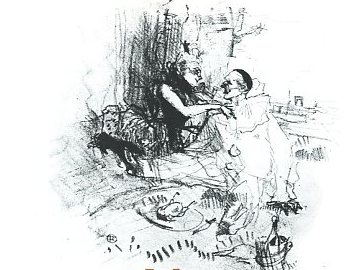Le Pique-Nique was probably not Toulouse-Lautrec’s title because the French did not use pique-nique for such a meal.
The subject is the Pierrot, the sad-sack clown, with whom Lautrec identified as a man who does not get the genuine affection of the woman he loves. Lautrec’s Pierrot is comfortable sharing his Picnic with an admirer, a sea change for Pierrot and a dream fulfilled for Lautrec.
Lautrec’s resource for Pierrot is probably an adaptation of Auguste Bouquet’s Le Repas de Pierrot (1834), a more traditional rendering of a sad-sack Pierrot, drunken, mournful, and waiting alone for someone who never appears. Bouquet’s setting is rustic, Lautrec’s is urban, and the Arc de Triomphe is visible in the right background. The picnic foods are similar: chicken, bread, and wine. Naming this scene Le Pique-Nique is rare because it is an outdoor meal, usually referred to as un partie de campagne, as in a lithograph of that name, completed a year earlier (1897).
In Toulouse-Lautrec: His Complete Lithographs and Drypoints (1965), Jean Adbémar suggests that the work was commissioned as a poster for Adolphe Willette’s La Vache Enragée, a trendy short-lived magazine.
See Henri Toulouse-Lautrec. Partie de Campagne (1897), lithograph on paper. National Gallery of Art, Washington, D.C.

